Sampling Procedure for Establishing Criteria for Sea Urchin (Loxechinus albus) Proportion under the Legal Minimum Length of landings
Abstract
:1. Introduction
2. Methodology
- Step 1.
- Requires a statistical procedure that allows assessment of the level of risk of the vessel under evaluation and that provides a less subjective selection criterion. Considering the complexity of this feature, it will be assumed that the vessel has already been selected, and the possibility of a subsequent study focused on this step remains.
- Step 2.
- After selecting the vessel, the number of sea urchin boxes after the landing is to be estimated. This estimate will provide the total of the units to be sampled and will depend on vessel capacity (N).
- Step 3.
- After estimating the number of boxes on the inspected vessel, the following procedure consists of evaluating how many boxes will be studied (n).
- Step 4.
- Once the size of the sample to be evaluated is known, it must be selected. To do so, a systematic sampling plan is carried out during landings and whose procedure is found in Appendix B.
- Step 5.
- Once the value of nhas been obtained and the systematic sampling of the weight of the boxes carried out, the boxes are studied to see if they meet the acceptance criterion.
- Step 6.
- Having calculated the cut-off point by using the ROC curves and having classified boxes as conforming and non-conforming, if the number of the latter exceeded the maximum allowable value, the final procedure consisted of evaluating the tolerance percentage. This was with equation:where m represents the weight of the non-conforming boxes, c the total of non-conforming boxes, k the weight of the boxes (conforming and non-conforming), h the total number of boxes contained in the sample, and correspond to the absolute value of x.
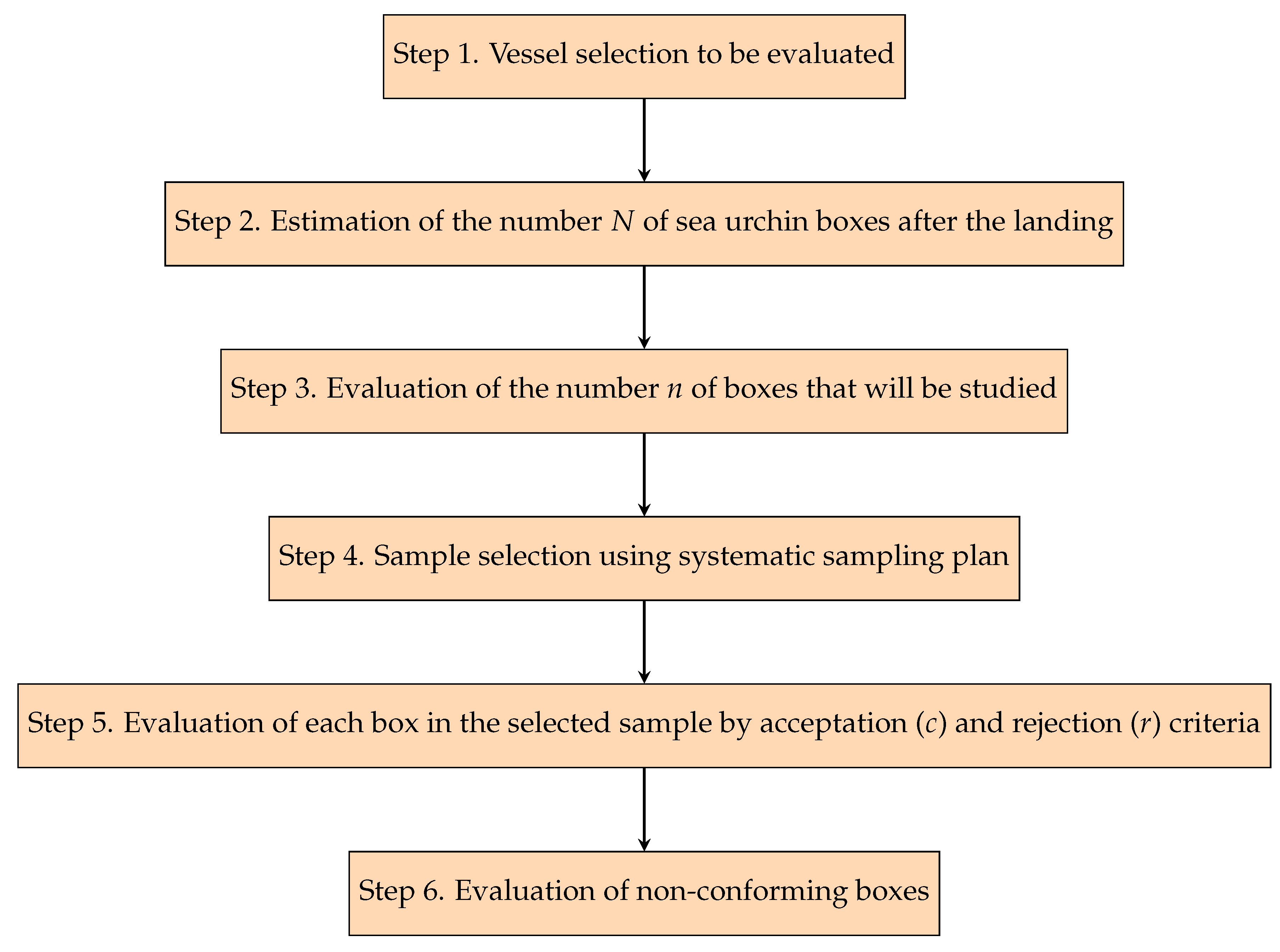
3. Results
3.1. Melinka Port
3.2. Quellón Port and Study Area Excluding Melinka
4. Discussion and Conclusions
Supplementary Materials
Author Contributions
Acknowledgments
Conflicts of Interest
Appendix A. Glossary
Appendix B. Procedure to Select the Containers to Be Evaluated in Sample n, Following Systematic Sampling
- Obtain an ordered list of N elements of the population.
- Determine sample size n.
- Define the size of the systematic jump k given by .
- Choose a random number between one and k (: random start). This number allows obtaining the first sample unit.
- From position , jumping k units will get to the second unit of the sample , and this way jumping from k in k units, the rest of the sample will be formed by units .
- Define the size of the systematic jump: this is calculated by .
- Select a random number between one and 76 (for example, 35).
- Select the remaining elements of the sample, . The latter value was estimated using arithmetic progression:
Appendix C. R Code
References
- Contreras, C.; Niklitschek, E.; Molinet, C.; Díaz, P.; Díaz, M. Fishery-induced reductions in density and size truncation of sea urchin Loxechinus albus affects diversity and species composition in benthic communities. Estuar. Coast. Shelf Sci. 2019, 219, 409–419. [Google Scholar] [CrossRef]
- Barahona, N.; Araya, P.; Muñoz, G.; Vicencio, C.; Olguín, A.; Cavieres, J.; Canales, C.; Subiabre, D.; Techeira, C.; Hurtado, C. Programa de Seguimiento de las Pesquerías Bentónicas; Instituto de Fomento Pesquero: Valparaíso, Indiana, 2016; p. 2015. Available online: https://www.ifop.cl/wp-content/contenidos/uploads/RepositorioIfop/InformeFinal/P-583011.pdf (accessed on 15 May 2019).
- Molinet, C.; Barahona, N.; Díaz, M.; Díaz, P.A.; Millanao, M.O.; Araya, P.; Subiabre, D.; Niklitschek, E.J. Using Drift Video Transects and Maximum Likelihood Geostatistics for Quantifying and Monitoring Exploited Subpopulations of Loxechinus albus at a Mesoscale. Mar. Coast. Fish. Dyn. Manag. Ecosyst. Sci. 2016, 8, 70–80. [Google Scholar] [CrossRef] [Green Version]
- McClanahan, T.; Castilla, J.C. Fisheries Management: Progress Towards Sustainability; Blackwell Publishing: Oxford, UK, 2007. [Google Scholar]
- Roa-Ureta, R.H.; Molinet, C.; Barahona, N.; Araya, P. Hierarchical statistical framework to combine generalized depletion models and biomass dynamic models in the stock assessment of the Chilean sea urchin (Loxechinus albus) fishery. Fish. Res. 2015, 171, 59–67. [Google Scholar] [CrossRef]
- SUBPESCA. Cuota de Captura y Talla Mínima de Extracción de erizo. Plan de Manejo Zona Contigua X—XI Regiones; Comité Científico Técnico Bentónico; INFORME: Valparaíso, Chile, March 2017; Available online: http://www.subpesca.cl/portal/616/articles-95941_documento.pdf (accessed on 15 August 2018).
- Balboa, C.; Molinet, C.; Barahona, N.; Díaz, P.A.; Subiabre, D.; Gebauer, P. Using growth ring formation to study growth patterns of exploited sea urchin (Loxechinus albus) populations. Fish. Res. 2018, 201, 88–97. [Google Scholar] [CrossRef]
- Kino, S. Juvenile ecology of the sea urchin Loxechinus albus in Chiloé Island, Chile. Aquac. Sci. 2009, 57, 567–577. [Google Scholar]
- Kino, S. Transplantation of the sea urchin Loxechinus albus in Chiloé Island, Chile. Aquac. Sci. 2010, 58, 55–63. [Google Scholar]
- Molinet, C.; Moreno, C.A.; Niklitschek, E.; Matamala, M.; Neculman, M.; Arévalo, A.; Codjambassis, J.; Díaz, P.A.; Díaz, M. Reproduction of the sea urchin Loxechinus albus across a bathymetric gradient in the Chilean Inland Sea. Rev. Biol. Mar. Oceanogr. 2012, 47, 257–272. [Google Scholar] [CrossRef] [Green Version]
- Narvaez, C.A.; Johnson, L.E.; Sainte-Marie, B. Growth bands are an unreliable indicator of sea urchin age: Evidence from the laboratory and the literature. Limn. Oceanogr. Methods 2016, 14, 527–541. [Google Scholar] [CrossRef] [Green Version]
- Molinet, C.; Balboa, C.A.; Moreno, C.A.; Díaz, M.; Gebauer, P.; Niklitschek, E.J.; Barahona, N. Variability in the growth patterns of Loxechinus albus along a bathymetric gradient associated with a fishing ground. Bull. Mar. Sci. 2013, 89, 699–716. [Google Scholar] [CrossRef]
- INN. Procedimientos de muestreo para inspección de atributos - Planes de muestreo indexados por nivel de calidad aceptable (AQL) para la inspección lote por lote; Instituto Nacional de Normalización, Norma Chilena Oficial: Santiago, Chile, 2007. [Google Scholar]
- Cabrera, R.; Valero-Franco, C.; Piniella, F.; Díaz, C.; Gómez-Cama, M.C.; Soriguer, M.C.; Hernando, J.A. A software tool for monitoring legal minimum length of landings: Case study of a fishery in southern Spain. Mar. Pol. 2012, 36, 895–902. [Google Scholar] [CrossRef] [Green Version]
- SUBPESCA. Establece talla mínima de extracción para el recurso erizo y margen de tolerancia en área y período que indica; Resolución Extenta Nro 910; Subsecretaría de Pesca y Acuicultura: Valparaíso, Chile, 15 March 2019; Available online: http://www.subpesca.cl/portal/615/articles-103618_documento.pdf (accessed on 15 May 2019).
- SUBPESCA. Establece margen de tolerancia bajo la talla mínima de extracción para el recurso erizo en área y periódo que indica; Resolución Extenta Nro 2158; Subsecretaría de Pesca y Acuicultura: Valparaíso, Chile, 11 July 2019; Available online: http://www.subpesca.cl/portal/615/articles-104538_documento.pdf (accessed on 15 August 2019).
- SERNAPESCA. Servicio Nacional de Pesca y Acuicultura, Valparaíso, Chile. 2019. Available online: http://www.sernapesca.cl/ (accessed on 15 August 2018).
- Grant, E.L.; Leavenworth, R.S. Statistical Quality Control, 6th ed.; McGraw-Hill: New York, NY, USA, 1988. [Google Scholar]
- Hildebrandt, G. Sampling plans on microbiological criteria. In Encyclopedia of Food Microbiology, 2nd ed.; Elsevier: San Diego, CA, USA, 2014; Volume 3. [Google Scholar]
- IFOP. Instituto de Fomento Pesquero, Valparaíso, Chile. 2017. Available online: https://www.ifop.cl/en/ (accessed on 15 August 2018).
- Molinet, C.; Barahona, N.; Yannicelli, B.; González, J.; Arevalo, A.; Rosales, S. Statistical and empirical identification of multispecies harvesting zones to improve monitoring, assessment, and management of benthic fisheries in Southern Chile. Bull. Mar. Sci. 2011, 897, 351–375. [Google Scholar] [CrossRef]
- R Core Team. R: A Language and Environment for Statistical Computing; R Foundation for Statistical Computing: Vienna, Austria, 2018; ISBN 3-900051-07-0. Available online: http://www.R-project.org/ (accessed on 15 August 2018).
- Quintero, F.O.L.; Contreras-Reyes, J.E.; Wiff, R.; Arellano-Valle, R.B. Flexible Bayesian analysis of the von Bertalanffy growth function with the use of a log-skew-t distribution. Fish. Bull. 2017, 115, 13–26. [Google Scholar] [CrossRef]
- Contreras-Reyes, J.E.; Quintero, F.O.L.; Yáñez, A.A. Towards age determination of Southern King crab (Lithodes Santolla) off Southern Chile using flexible mixture modeling. J. Mar. Sci. Eng. 2018, 6, 157. [Google Scholar] [CrossRef] [Green Version]
- Contreras-Reyes, J.E.; Cortés, D.D. Bounds on Rényi and Shannon Entropies for Finite Mixtures of Multivariate Skew-Normal Distributions: Application to Swordfish (Xiphias gladius Linnaeus). Entropy 2016, 18, 382. [Google Scholar] [CrossRef]
- Walker, K.; Aranis, A.; Contreras-Reyes, J.E. Possible Criterion to Estimate the Juvenile Reference Length of Common Sardine (Strangomera bentincki) off Central-Southern Chile. J. Mar. Sci. Eng. 2018, 6, 82. [Google Scholar] [CrossRef] [Green Version]
- Olave, S.; Bustos, E.; Lawrence, J.M.; Cárcamo, P. The effect of size and diet on gonad production by the Chilean sea urchin Loxechinus albus. J. World Aquac. Soc. 2001, 32, 210–214. [Google Scholar] [CrossRef]
- Espinoza, R.; Arriagada, S. Repoblamiento de Loxechinus albus: Manual de producción de semilla con fines de repoblamiento; Project HUAM AQ08I1024; FONDEF, Universidad de Los Lagos: Puerto Montt, Chile, 2017. [Google Scholar]
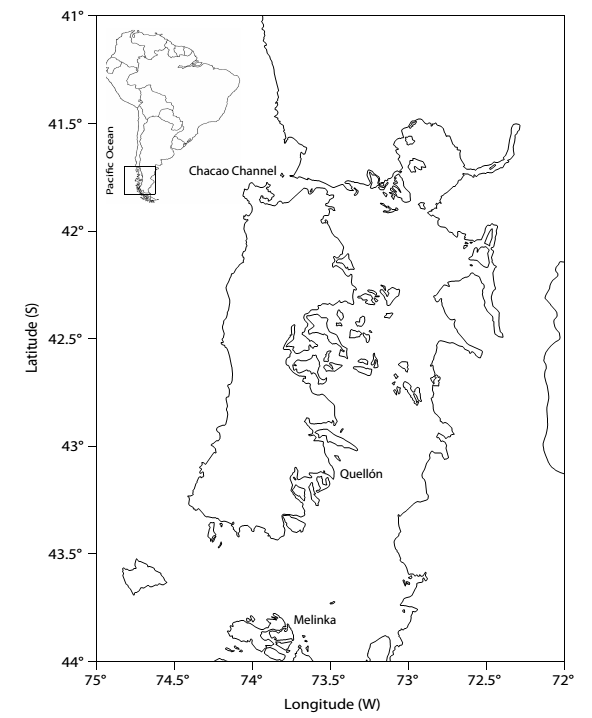
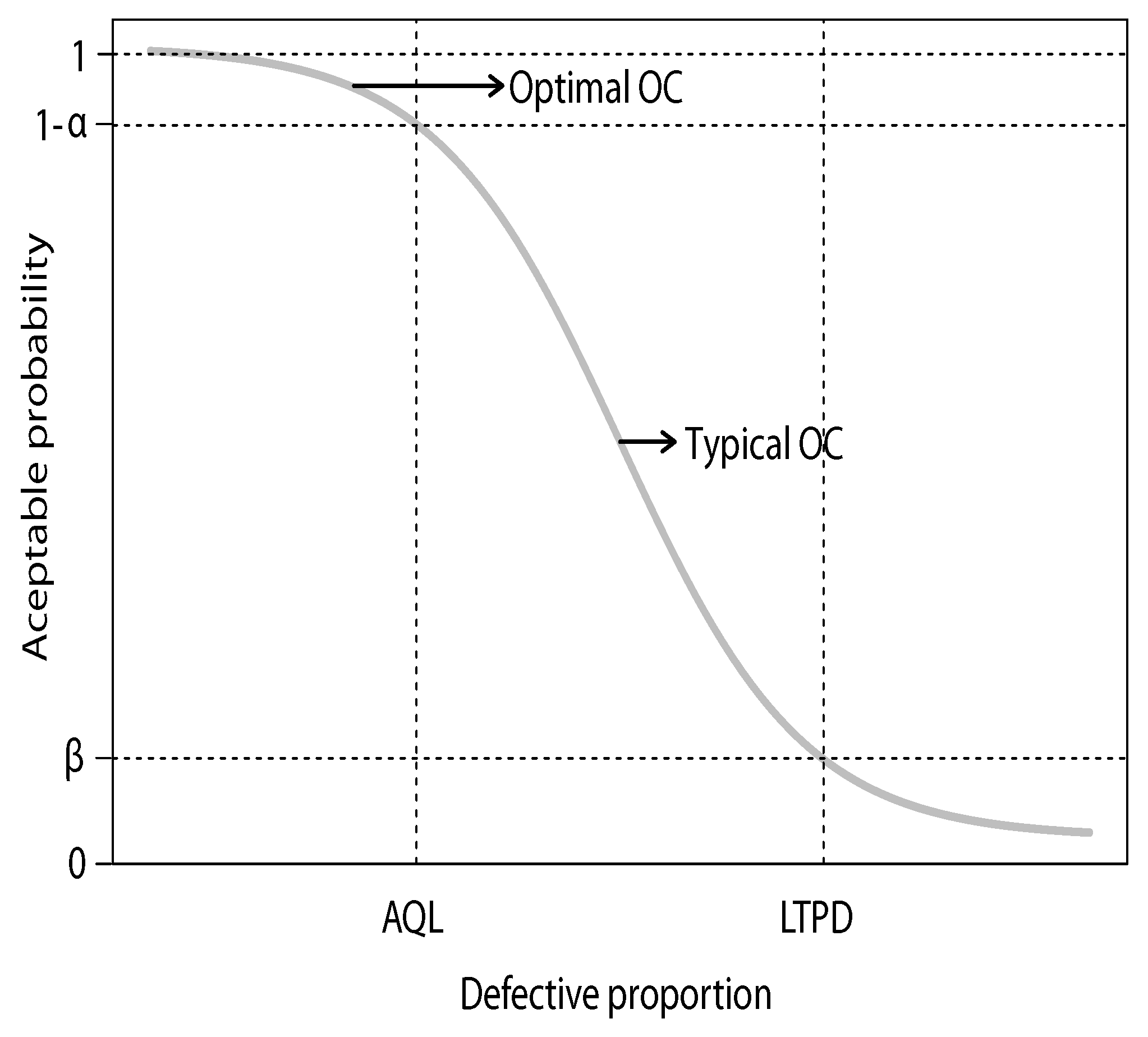
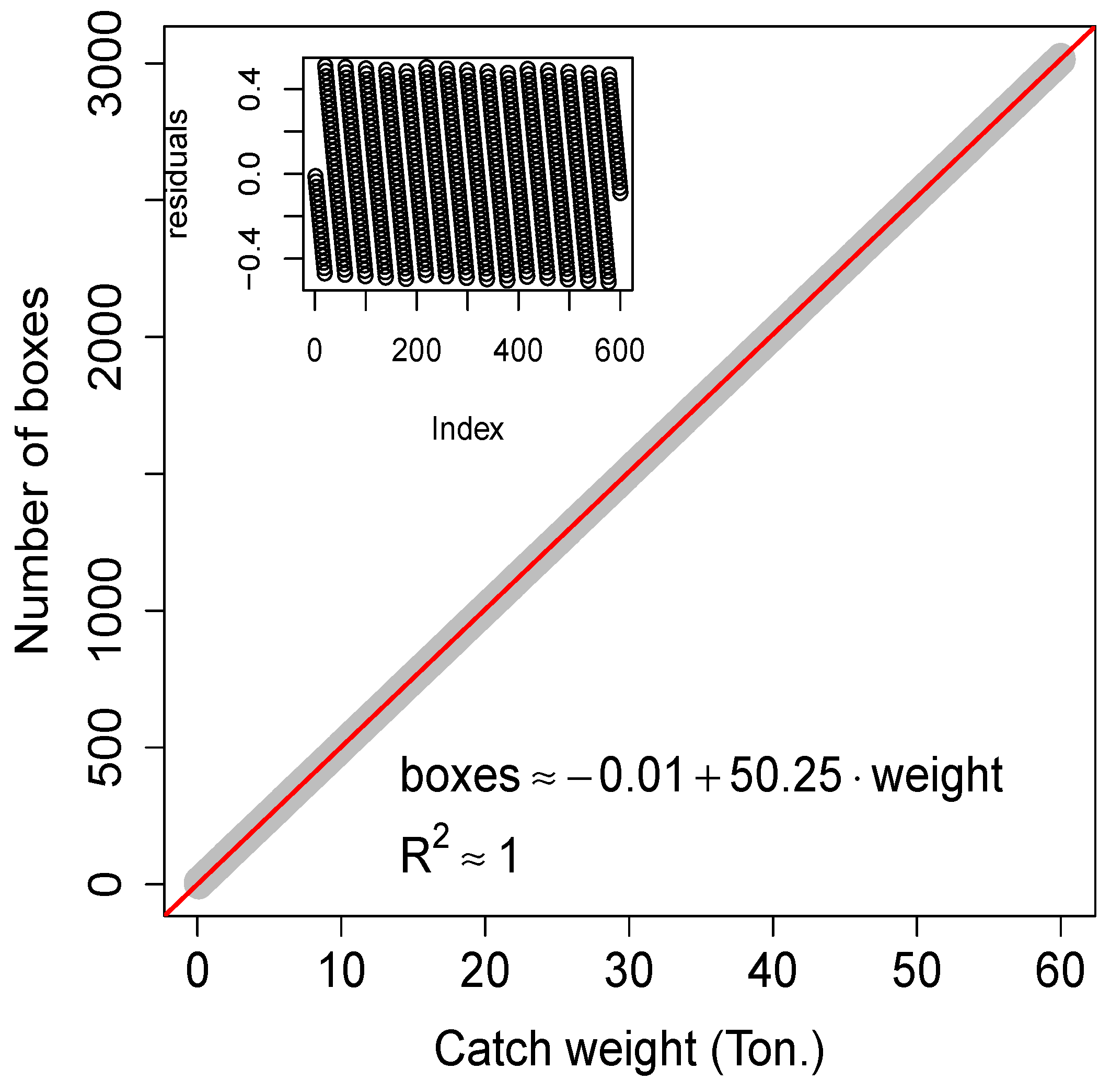
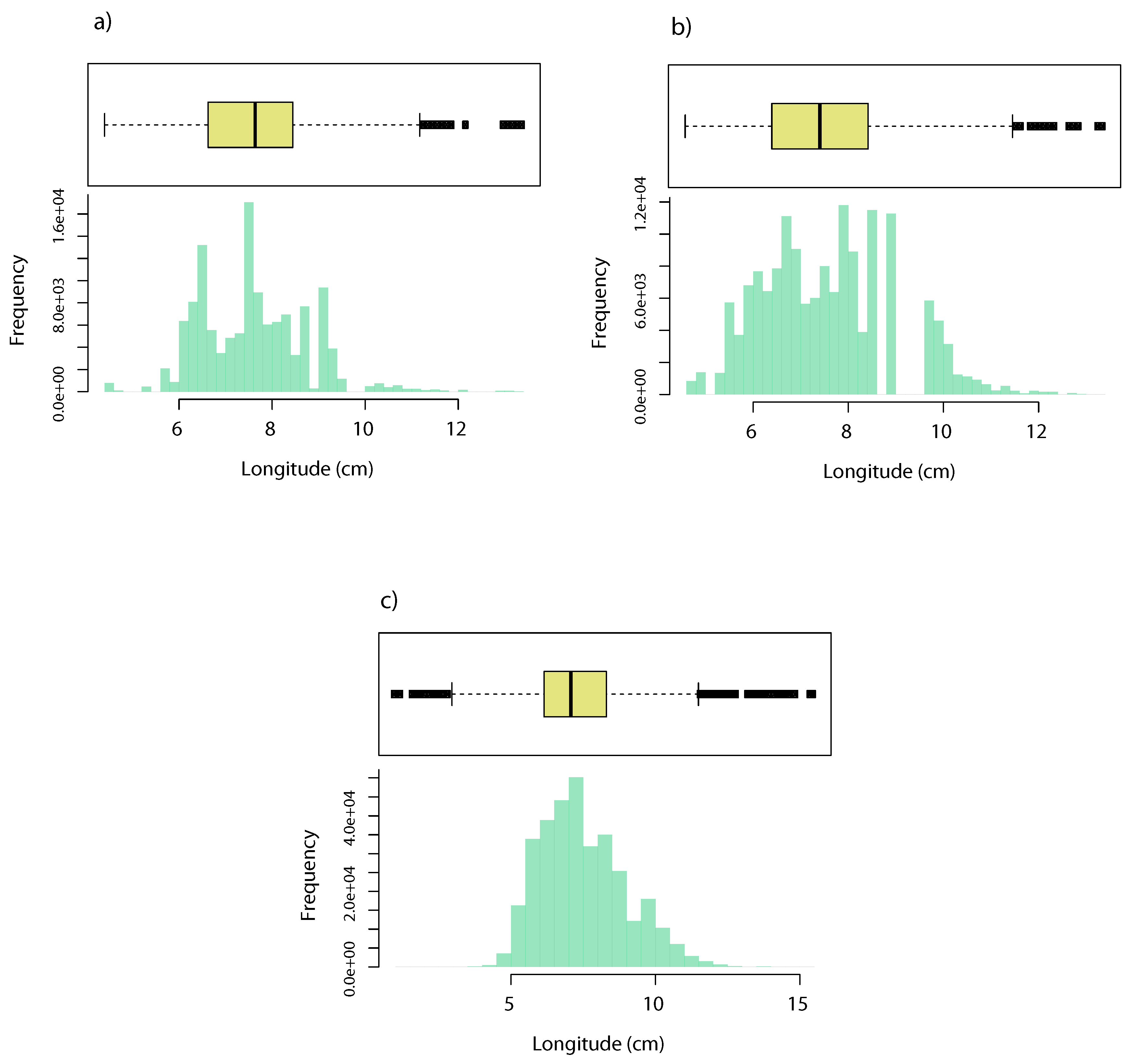
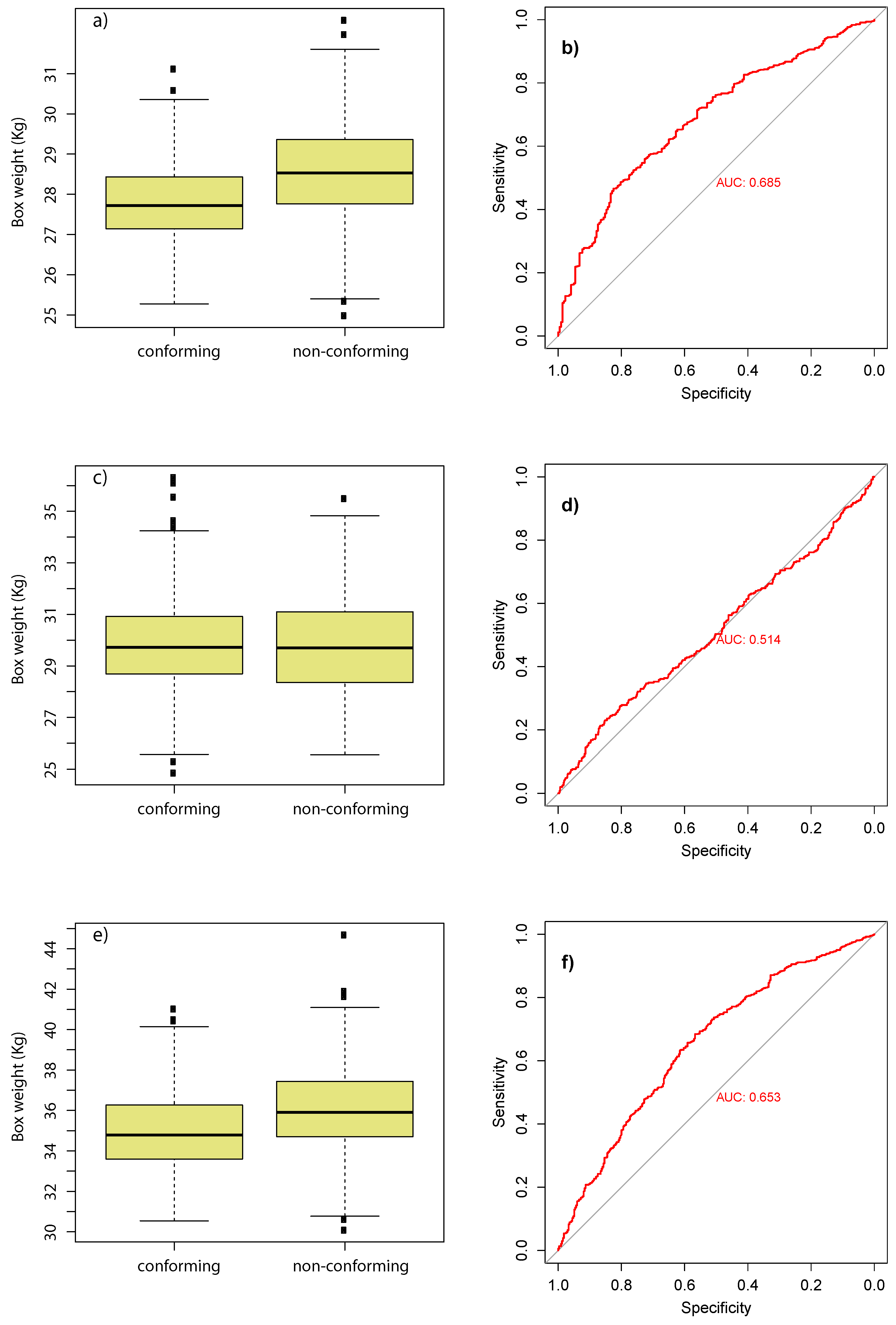
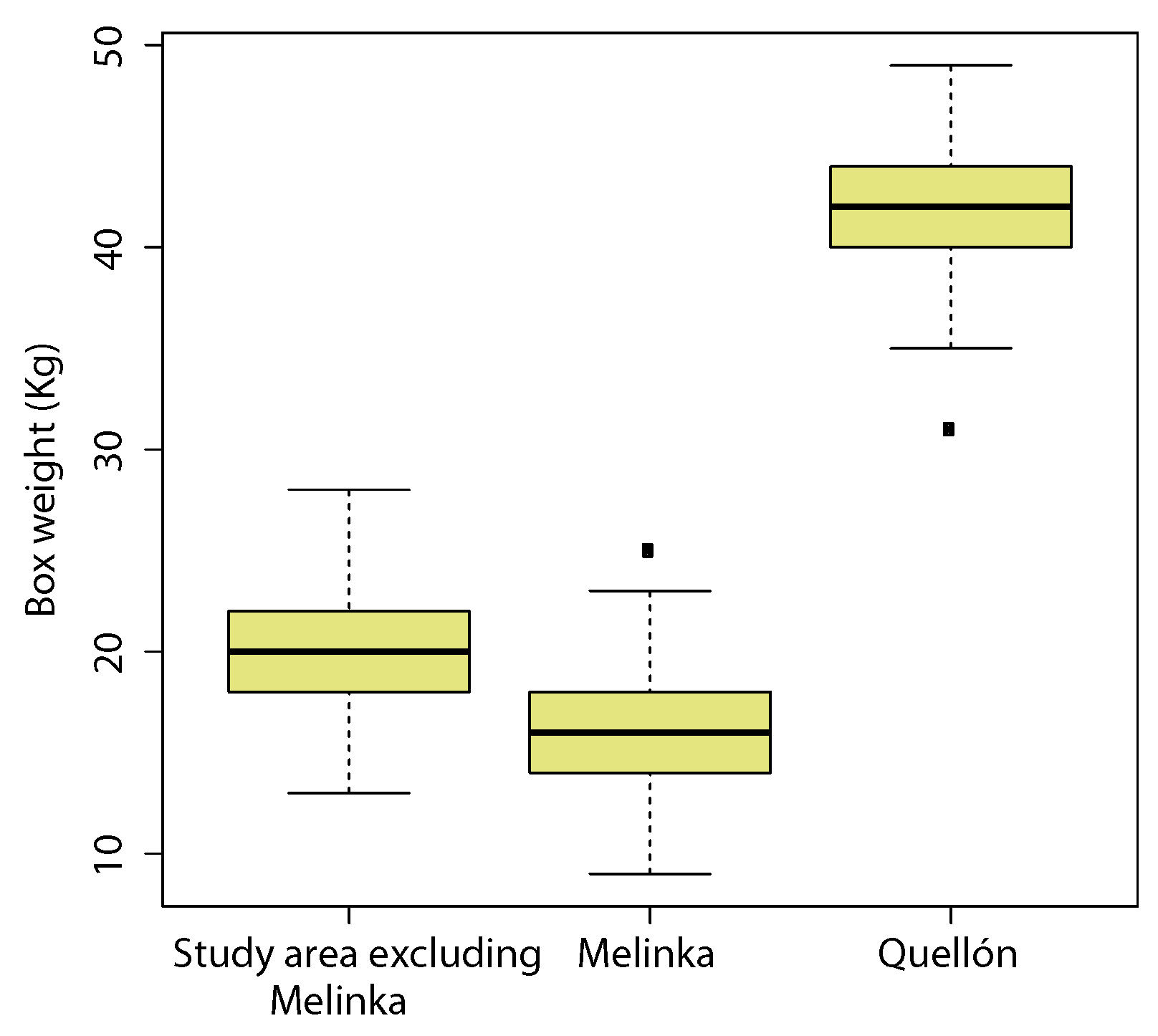
| Regulation 44 | Optimization | |||||
|---|---|---|---|---|---|---|
| ≤25 | 5 | 1 | 2 | 5 | 1 | 2 |
| 26–50 | 8 | 2 | 3 | 8 | 2 | 3 |
| 51–90 | 13 | 3 | 4 | 10 | 2 | 3 |
| 91–150 | 20 | 5 | 6 | 17 | 4 | 5 |
| 151–280 | 32 | 7 | 8 | 28 | 6 | 7 |
| 281–500 | 50 | 10 | 11 | 40 | 8 | 9 |
| 501–1200 | 80 | 14 | 15 | 65 | 11 | 12 |
| ≥1201 | 125 | 21 | 22 | 105 | 17 | 18 |
| Statistic | Melinka Port | Quellón Port | Studied Area Excluding Melinka Port |
|---|---|---|---|
| n | 125,579 | 154,624 | 331,531 |
| Minimum | 4.4 | 4.7 | 1.4 |
| 1st quartile | 6.6 | 6.5 | 6.4 |
| Median | 7.6 | 7.5 | 7.3 |
| Mean | 7.65 | 7.62 | 7.56 |
| 3 quartile | 8.4 | 8.5 | 8.5 |
| Maximum | 13.3 | 13.4 | 15.5 |
| Landing Ports’ UMLS | 5.5 cm | 6.0 cm | 6.5 cm | 7.0 cm |
|---|---|---|---|---|
| Melinka | ||||
| Conformity | – | – | 239 | – |
| Non-conformity | – | – | 761 | – |
| Cut-off point | – | – | 28,146.5 | – |
| Specificity | – | – | 65.1 | – |
| Sensitivity | – | – | 63.2 | – |
| Quellón | ||||
| Conformity | 351 | 640 | 4 | – |
| Non-conformity | 649 | 360 | 996 | 1000 |
| Cut-off point | 295,770 | 298,265 | – | – |
| Specificity | 53.3 | 52.9 | – | – |
| Sensitivity | 59.0 | 53.6 | – | – |
| Studied area excluding | ||||
| Melinka Port | ||||
| Conformity | 54 | 306 | 1 | – |
| Non-conformity | 946 | 694 | 999 | 1000 |
| Cut-off point | 363,175 | 355,105 | – | – |
| Specificity | 62.9 | 58.5 | – | – |
| Sensitivity | 62.9 | 61.8 | – | – |
| Evaluation of Boxes Considering the Cut-Off Point | ||
|---|---|---|
| Evaluation | Conformity | Non- Conformity |
| Conformity | 112 | 0 |
| Non-conformity | 33 | 2 |
| Total | 145 | 2 |
© 2020 by the authors. Licensee MDPI, Basel, Switzerland. This article is an open access article distributed under the terms and conditions of the Creative Commons Attribution (CC BY) license (http://creativecommons.org/licenses/by/4.0/).
Share and Cite
Di Giorgi, G.; Querales, M.; Contreras-Reyes, J.E.; Pereira, D.; Hernández-Santoro, C. Sampling Procedure for Establishing Criteria for Sea Urchin (Loxechinus albus) Proportion under the Legal Minimum Length of landings. J. Mar. Sci. Eng. 2020, 8, 102. https://doi.org/10.3390/jmse8020102
Di Giorgi G, Querales M, Contreras-Reyes JE, Pereira D, Hernández-Santoro C. Sampling Procedure for Establishing Criteria for Sea Urchin (Loxechinus albus) Proportion under the Legal Minimum Length of landings. Journal of Marine Science and Engineering. 2020; 8(2):102. https://doi.org/10.3390/jmse8020102
Chicago/Turabian StyleDi Giorgi, Gustavo, Marvin Querales, Javier E. Contreras-Reyes, Danilo Pereira, and Carola Hernández-Santoro. 2020. "Sampling Procedure for Establishing Criteria for Sea Urchin (Loxechinus albus) Proportion under the Legal Minimum Length of landings" Journal of Marine Science and Engineering 8, no. 2: 102. https://doi.org/10.3390/jmse8020102






